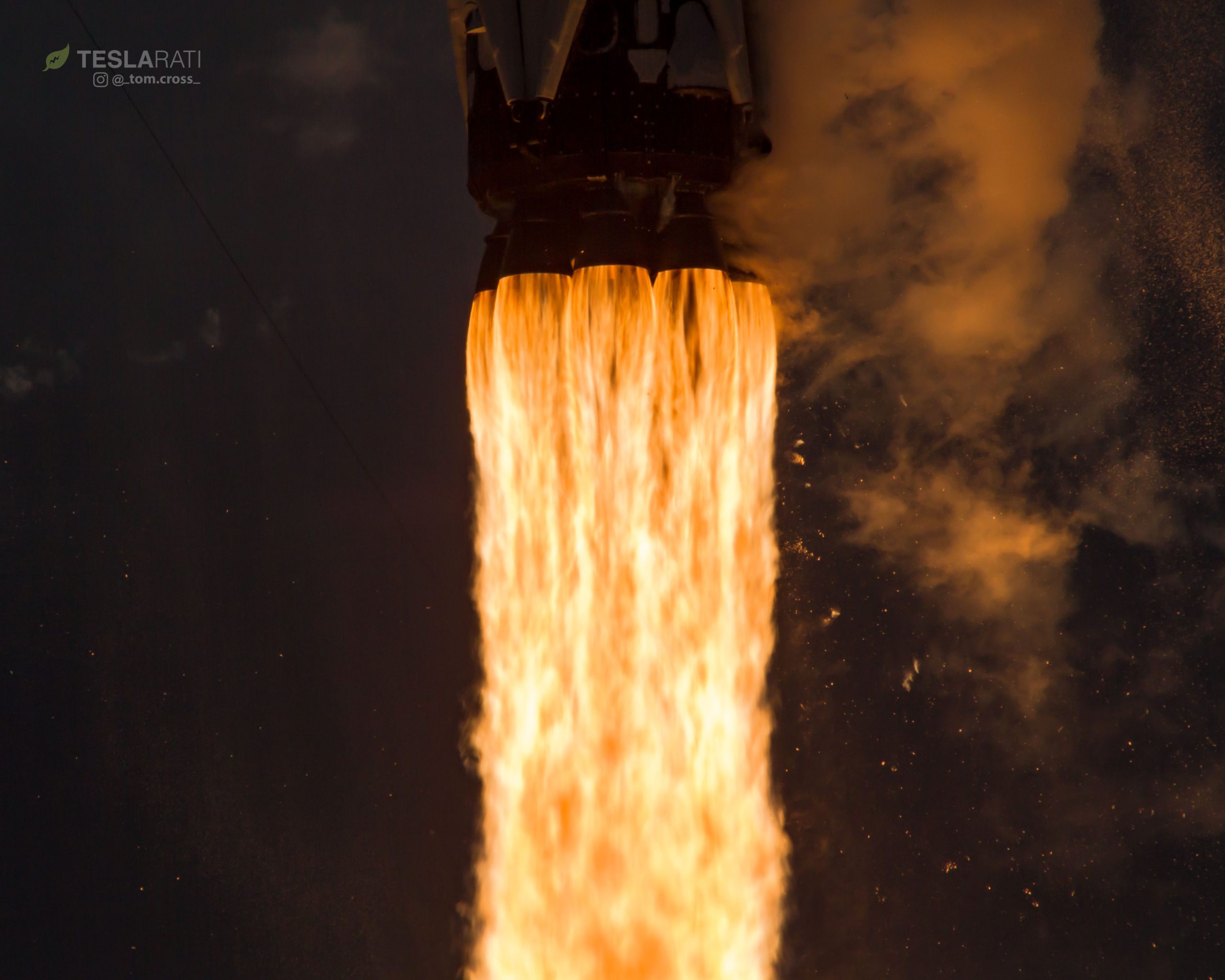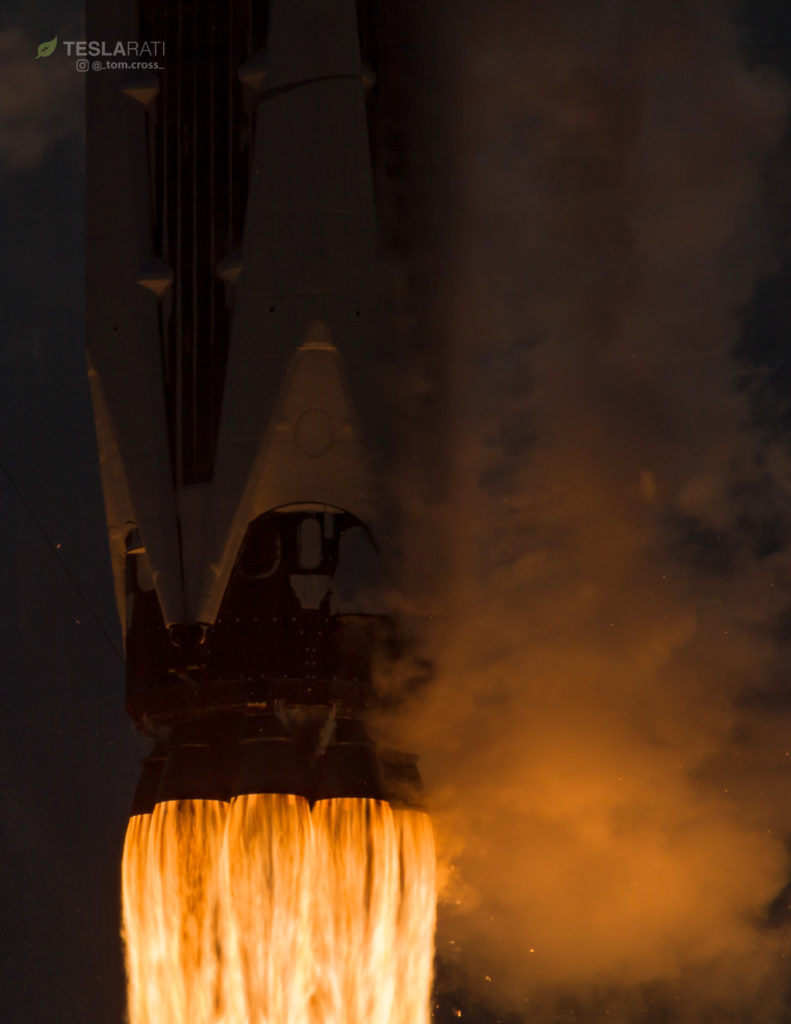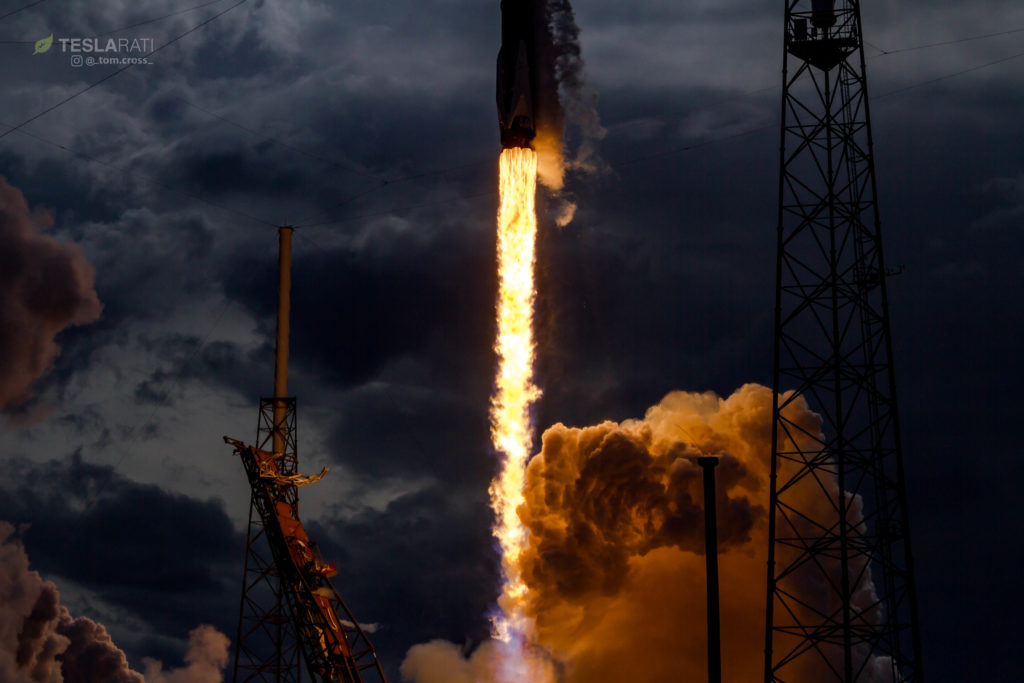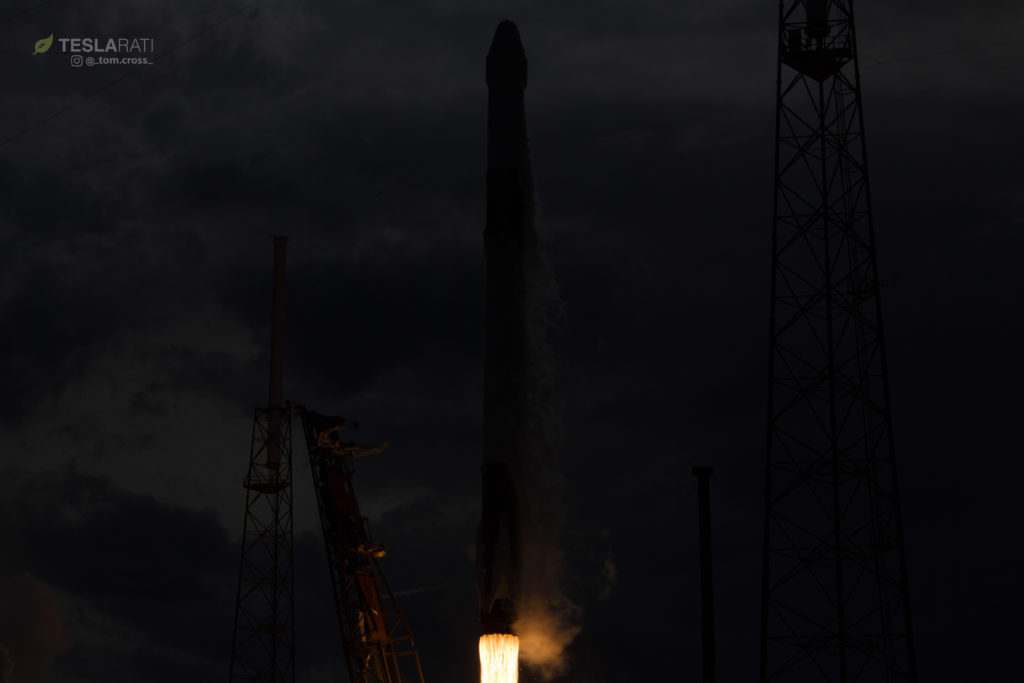

News
SpaceX expends “old-gen” Falcon 9 to ready for upcoming rapid reuse rocket
Falcon 9 B1039 completed its fourteenth Cargo Dragon (CRS-14) launch with a dramatic, Falcon Heavy-esque hard impact into the Atlantic Ocean – as an expendable mission, its purpose, in this case, was to gather data on Falcon 9’s performance during extreme reentry conditions.
Aside from the inherent benefits of gathering critical data ahead of the April 24 debut of Falcon 9 Block 5, a rapid reuse version of the booster that SpaceX is not likely to be keen on expending, exploring the limits of Falcon 9’s ability to reenter Earth’s atmosphere could enable a greater proportion of missions to be recoverable in the future. In the past, Falcon 9 Block 3 was effectively limited to recovery attempts for geostationary payloads below 5400 kg, evidenced by three intentionally expendable (no recovery attempt) 2017 launch with satellites that weighed anywhere from 5500-6700kg.
- CRS-14. (Tom Cross)
Soon after, however, SpaceX introduced Block 4 of Falcon 9, most prominently featuring uprated Merlin 1D engines capable of around 10% more thrust than Block 3. Presumably related to this thrust upgrade, SpaceX recently announced that they would attempt an exceptionally hot booster recovery following the launch of the 6100 kg Hispasat 30W-6 communications satellite, an intent that was confirmed by the presence of titanium grid fins. Sadly, bad sea conditions in the Atlantic scrubbed the launch attempt, and the booster (B1044) instead attempted a soft landing in the ocean. Still, the intent alone demonstrated that SpaceX believed it could potentially land a Falcon 9 first stage despite the considerable mass of the satellite, effectively a 15% capability upgrade that would allow SpaceX to recover boosters after all but a tiny proportion.

Falcon 9 B1039 takes to the stormy skies. (Tom Cross)
It may feel unintuitive (perhaps even sad) seeing SpaceX expend booster after recoverable booster, but the company is almost certainly making a pragmatic decision to use the final flight-proven Block 3 and Block 4 first stages to flesh out the full range of their capabilities and explore the edge of the envelope ahead of the next generation. As SpaceX’s Jessica Jensen noted in both pre- and post-launch press conferences, these decisions to expend recoverable boosters are made on a case-by-case basis after considerable thought and cost-benefit analysis – in other words, the decisions to send these boosters to their watery graves are made with an eye on the future of Falcon 9 and Heavy.
Tom Cross’ incredible photos from this launch truly manage to capture the wildly dramatic mood of rocketry – even expendable vehicles never cease to amaze. In the background, a thunderstorm loomed large over the mission, but thankfully allowed a flight-proven Dragon and Falcon 9 booster to squeak by on their way to orbit.
- Falcon 9 B1039 takes to the stormy skies. (Tom Cross)
Follow us for live updates, behind-the-scenes sneak peeks, and a sea of beautiful photos from our East and West coast photographers.
Teslarati – Instagram – Twitter
Tom Cross – Twitter
Pauline Acalin – Twitter
Eric Ralph – Twitter

Elon Musk
Elon Musk and Tesla AI Director share insights after empty driver seat Robotaxi rides
The executives’ unoccupied tests hint at the rapid progress of Tesla’s unsupervised Robotaxi efforts.

Tesla CEO Elon Musk and AI Director Ashok Elluswamy celebrated Christmas Eve by sharing personal experiences with Robotaxi vehicles that had no safety monitor or occupant in the driver’s seat. Musk described the system’s “perfect driving” around Austin, while Elluswamy posted video from the back seat, calling it “an amazing experience.”
The executives’ unoccupied tests hint at the rapid progress of Tesla’s unsupervised Robotaxi efforts.
Elon and Ashok’s firsthand Robotaxi insights
Prior to Musk and the Tesla AI Director’s posts, sightings of unmanned Teslas navigating public roads were widely shared on social media. One such vehicle was spotted in Austin, Texas, which Elon Musk acknowleged by stating that “Testing is underway with no occupants in the car.”
Based on his Christmas Eve post, Musk seemed to have tested an unmanned Tesla himself. “A Tesla with no safety monitor in the car and me sitting in the passenger seat took me all around Austin on Sunday with perfect driving,” Musk wrote in his post.
Elluswamy responded with a 2-minute video showing himself in the rear of an unmanned Tesla. The video featured the vehicle’s empty front seats, as well as its smooth handling through real-world traffic. He captioned his video with the words, “It’s an amazing experience!”
Towards Unsupervised operations
During an xAI Hackathon earlier this month, Elon Musk mentioned that Tesla owed be removing Safety Monitors from its Robotaxis in Austin in just three weeks. “Unsupervised is pretty much solved at this point. So there will be Tesla Robotaxis operating in Austin with no one in them. Not even anyone in the passenger seat in about three weeks,” he said. Musk echoed similar estimates at the 2025 Annual Shareholder Meeting and the Q3 2025 earnings call.
Considering the insights that were posted Musk and Elluswamy, it does appear that Tesla is working hard towards operating its Robotaxis with no safety monitors. This is quite impressive considering that the service was launched just earlier this year.
Elon Musk
Starlink passes 9 million active customers just weeks after hitting 8 million
The milestone highlights the accelerating growth of Starlink, which has now been adding over 20,000 new users per day.

SpaceX’s Starlink satellite internet service has continued its rapid global expansion, surpassing 9 million active customers just weeks after crossing the 8 million mark.
The milestone highlights the accelerating growth of Starlink, which has now been adding over 20,000 new users per day.
9 million customers
In a post on X, SpaceX stated that Starlink now serves over 9 million active users across 155 countries, territories, and markets. The company reached 8 million customers in early November, meaning it added roughly 1 million subscribers in under seven weeks, or about 21,275 new users on average per day.
“Starlink is connecting more than 9M active customers with high-speed internet across 155 countries, territories, and many other markets,” Starlink wrote in a post on its official X account. SpaceX President Gwynne Shotwell also celebrated the milestone on X. “A huge thank you to all of our customers and congrats to the Starlink team for such an incredible product,” she wrote.
That growth rate reflects both rising demand for broadband in underserved regions and Starlink’s expanding satellite constellation, which now includes more than 9,000 low-Earth-orbit satellites designed to deliver high-speed, low-latency internet worldwide.
Starlink’s momentum
Starlink’s momentum has been building up. SpaceX reported 4.6 million Starlink customers in December 2024, followed by 7 million by August 2025, and 8 million customers in November. Independent data also suggests Starlink usage is rising sharply, with Cloudflare reporting that global web traffic from Starlink users more than doubled in 2025, as noted in an Insider report.
Starlink’s momentum is increasingly tied to SpaceX’s broader financial outlook. Elon Musk has said the satellite network is “by far” the company’s largest revenue driver, and reports suggest SpaceX may be positioning itself for an initial public offering as soon as next year, with valuations estimated as high as $1.5 trillion. Musk has also suggested in the past that Starlink could have its own IPO in the future.
News
NVIDIA Director of Robotics: Tesla FSD v14 is the first AI to pass the “Physical Turing Test”
After testing FSD v14, Fan stated that his experience with FSD felt magical at first, but it soon started to feel like a routine.

NVIDIA Director of Robotics Jim Fan has praised Tesla’s Full Self-Driving (Supervised) v14 as the first AI to pass what he described as a “Physical Turing Test.”
After testing FSD v14, Fan stated that his experience with FSD felt magical at first, but it soon started to feel like a routine. And just like smartphones today, removing it now would “actively hurt.”
Jim Fan’s hands-on FSD v14 impressions
Fan, a leading researcher in embodied AI who is currently solving Physical AI at NVIDIA and spearheading the company’s Project GR00T initiative, noted that he actually was late to the Tesla game. He was, however, one of the first to try out FSD v14.
“I was very late to own a Tesla but among the earliest to try out FSD v14. It’s perhaps the first time I experience an AI that passes the Physical Turing Test: after a long day at work, you press a button, lay back, and couldn’t tell if a neural net or a human drove you home,” Fan wrote in a post on X.
Fan added: “Despite knowing exactly how robot learning works, I still find it magical watching the steering wheel turn by itself. First it feels surreal, next it becomes routine. Then, like the smartphone, taking it away actively hurts. This is how humanity gets rewired and glued to god-like technologies.”
The Physical Turing Test
The original Turing Test was conceived by Alan Turing in 1950, and it was aimed at determining if a machine could exhibit behavior that is equivalent to or indistinguishable from a human. By focusing on text-based conversations, the original Turing Test set a high bar for natural language processing and machine learning.
This test has been passed by today’s large language models. However, the capability to converse in a humanlike manner is a completely different challenge from performing real-world problem-solving or physical interactions. Thus, Fan introduced the Physical Turing Test, which challenges AI systems to demonstrate intelligence through physical actions.
Based on Fan’s comments, Tesla has demonstrated these intelligent physical actions with FSD v14. Elon Musk agreed with the NVIDIA executive, stating in a post on X that with FSD v14, “you can sense the sentience maturing.” Musk also praised Tesla AI, calling it the best “real-world AI” today.















